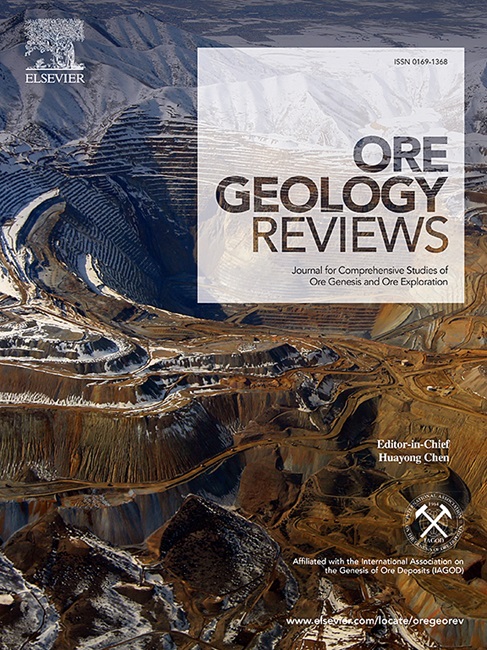中国东部桥马山铜矽卡岩矿床热液演化和金属来源的流体包裹体和多同位素地球化学制约因素
IF 3.2
2区 地球科学
Q1 GEOLOGY
引用次数: 0
摘要
中国东部的宣城矿区是长江中下游成矿带(MLYB)中新发现的一个矿区,拥有多个岩浆热液相关矿床。桥马山矿床是该区矽卡岩矿床的代表,也是该区唯一的钨矿化矿床。然而,金属的来源和形成该矿床的成矿系统的热液演化仍存在争议。本研究利用新的流体包裹体微测温和同位素数据(包括流体包裹体H、石英O、硫化物S和黄铁矿Pb数据)解决了这些问题,这些数据制约了该系统内热液的演化和桥马山矿床的金属来源。这项研究确定了矿床内热液演化和成矿作用的三个主要阶段,即前成矿(第一阶段)、同成矿(第二和第三阶段)和后成矿阶段。第一阶段的石榴石(安拉铁矿)寄生流体包裹体在 390 °C 至 590 °C 之间均质,盐度为 9-20 wt% NaCl 当量,而第二阶段的石英寄生流体包裹体在 200 °C 至 460 °C 之间均质,盐度为 5-18 wt% NaCl 当量。最后,第 3 阶段的石英和方解石包裹体在 120 ℃-240 ℃ 的温度和 3-15 wt% 的 NaCl 当量盐度下均化。第2阶段石英的氧和氢同位素组成(δDfluid从-99‰到-57‰;δ18Ofluid从4.0‰到6.1‰)接近岩浆流体的预期组成,而第3阶段石英(δDfluid从-105‰到-86‰;δ18Ofluid从-1.7到-0.6‰)记录了陨石流体和热液岩浆流体的混合。这些流体包裹体数据表明,冷却是第一和第二阶段的主要成矿过程,这一过程可能有利于钨和铜在残余热液中的富集。相反,流体混合在第 2 和第 3 阶段变得越来越重要,导致盐度和温度降低以及流体同位素组成的变化。在矿床形成过程中,水与岩石(W/R)的相互作用也可能是一个重要的过程。桥马山矿床硫化物的δ34S(2.7 ‰-5.7 ‰,平均值为 4.3 ‰)也为矿床内的硫来源于岩浆提供了证据。桥马山矿床样品的同质黄铁矿铅同位素数据(206/204Pb = 18.158-18.518,207/204Pb = 15.592-15.650,208/204Pb = 36.179-38.634)进一步表明,矿床内的金属来源于地幔和地壳。总之,桥马山矿床的形成源于岩浆源的热液,这些热液冷却后与陨石水混合,经过W/R作用,导致硫化物沉淀。该地区存在的大尺度褶皱也可能是成矿流体的一个关键聚焦点,这也是用于矿产勘探的一个潜在载体,因为这些构造集中了岩浆活动和流体流动,促进了该地区矽卡岩矿化的形成。本文章由计算机程序翻译,如有差异,请以英文原文为准。

Fluid inclusion and multiple isotope geochemical constraints on the hydrothermal evolution and metal sources of the Qiaomaishan Cu–W skarn deposit, eastern China
The Xuancheng ore district of eastern China is a newly discovered district within the Middle and Lower Yangtze River Metallogenic Belt (MLYB) that hosts several magmato-hydrothermal related mineral deposits. The Qiaomaishan deposit is a representative example of the skarn deposits within this district and is also the only deposit within the district that hosts tungsten mineralization. However, the source of metals and the hydrothermal evolution of the mineralizing system that formed this deposit remain controversial. This study addresses these issues using new fluid inclusion microthermometric and isotopic data, including fluid inclusion H, quartz O, sulfide S, and pyrite Pb data, which constrain the evolution of the hydrothermal fluids within the system and the source of metal within the Qiaomaishan deposit. This study identified three main stages of hydrothermal evolution and paragenesis within the deposit, namely pre-ore (stage 1), syn-ore (stages 2 and 3), and post-ore formation stages. Stage 1 garnet (andradite)-hosted fluid inclusions homogenize between 390 °C and 590 °C and have salinities of 9–20 wt% NaCl equivalent whereas stage 2 quartz-hosted fluid inclusions homogenize between 200 °C and 460 °C and have salinities of 5–18 wt% NaCl equivalent. Finally, stage 3 quartz- and calcite-hosted fluid inclusions homogenize at temperatures of 120 °C–240 °C and 3–15 wt% NaCl equivalent salinities. The stage 2 quartz has oxygen and hydrogen isotopic compositions (δDfluid from −99 ‰ to −57 ‰; δ18Ofluid from 4.0 ‰ to 6.1 ‰) that are close to those expected for magmatic fluids, whereas stage 3 quartz (δDfluid from −105 ‰ to −86 ‰; δ18Ofluid from −1.7 to −0.6 ‰) records the mixing of meteoric and hydrothermal magmatic fluids. These fluid inclusion data suggest that cooling was the main mineralizing process involved in stages 1 and 2, and this process may favor the enrichment of tungsten and copper in the residual hydrothermal fluids. In contrast, fluid mixing became increasingly important between stages 2 and 3, leading to a reduction in salinity and temperature as well as changes in fluid isotopic compositions. Water–rock (W/R) interaction is also likely to have been an important process during deposit formation. The δ34S (2.7 ‰–5.7 ‰ with a mean of 4.3 ‰) of sulfides from the Qiaomaishan deposit also provide evidence that the sulfur within the deposit has a magmatic origin. The homogeneous pyrite Pb isotopic data (206/204Pb = 18.158–18.518, 207/204Pb = 15.592–15.650, and 208/204Pb = 36.179–38.634) for samples from the Qiaomaishan deposit further indicates that the metals within the deposit were derived from both mantle and crustal sources. In summary, the Qiaomaishan deposit formed from hydrothermal fluids derived from a magmatic source that subsequently cooled, mixed with meteoric water, and underwent W/R interaction, causing sulfide precipitation. The large-scale folding present in this area may also have been a key focus for mineralizing fluids and this a potential vector for use in mineral exploration as these structures focused both magmatism and fluid flow, promoting the formation of the skarn mineralization in this region.
求助全文
通过发布文献求助,成功后即可免费获取论文全文。
去求助
来源期刊

Ore Geology Reviews
地学-地质学
CiteScore
6.50
自引率
27.30%
发文量
546
审稿时长
22.9 weeks
期刊介绍:
Ore Geology Reviews aims to familiarize all earth scientists with recent advances in a number of interconnected disciplines related to the study of, and search for, ore deposits. The reviews range from brief to longer contributions, but the journal preferentially publishes manuscripts that fill the niche between the commonly shorter journal articles and the comprehensive book coverages, and thus has a special appeal to many authors and readers.
 求助内容:
求助内容: 应助结果提醒方式:
应助结果提醒方式:


